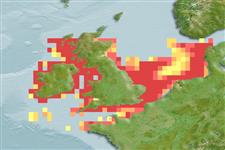Environment: milieu / climate zone / depth range / distribution range
বাস্তুসংস্থান
সামুদ্রিক তলদেশ বিহারী; গভীরতার পরিসীমা 25 - 80 m (Ref. 130215). Temperate; 58°N - 48°N, 11°W - 9°E
Northeast Atlantic: all coasts of the British Isles and English Channel to northern Biscay.
আকৃতি / ওজন / Age
Maturity: Lm ? range ? - ? cm
Max length : 35.0 cm SL পুরুষ/ লিঙ্গ অনিধর্ারিত ; (Ref. 4674)
Dark spot on each side of the snout absent (Ref. 35388).
Inhabits inshore and offshore, although only juveniles appear to occur close inshore. Feeds initially on zooplankton, but for lengths greater than 10 to 15 cm small fish, such as clupeids and ammodytids dominate the diet (Ref. 4674). Spawns in winter and has a more southern distribution (Ref. 35388).
Life cycle and mating behavior
পরিপক্কতা | প্রজনন | ডিম ছাড়া | ডিমসমূহ | ডিম্বধারন ক্ষমতা | শুককীট
Reay, P.J., 1986. Ammodytidae. p. 945-950. In P.J.P. Whitehead, M.-L. Bauchot, J.-C. Hureau, J. Nielsen and E. Tortonese (eds.) Fishes of the north-eastern Atlantic and the Mediterranean. UNESCO, Paris. Vol. 2. (Ref. 4674)
IUCN Red List Status (Ref. 130435)
Threat to humans
Harmless
Human uses
আরো তথ্য
সূত্র সংখ্যা এ্যাকুয়াকালচার (জলজ পালন) এ্যাকুয়াকালচার নকশা বংশ বংশানুগতিবিদ্যাElectrophoresesউতরাধিকার সুত্রে পাওয়া যোগ্যতারোগ প্রক্রিয়াজাতকরণ NutrientsMass conversion
হাতিয়ার
Special reports
Download XML
ইন্টারনেট সুত্র
Estimates based on models
Preferred temperature (Ref.
123201): 9.2 - 12.3, mean 10.8 °C (based on 144 cells).
Phylogenetic diversity index (Ref.
82804): PD
50 = 0.7500 [Uniqueness, from 0.5 = low to 2.0 = high].
Bayesian length-weight: a=0.00316 (0.00164 - 0.00611), b=3.06 (2.89 - 3.23), in cm total length, based on LWR estimates for this species & (Sub)family-body (Ref.
93245).
ট্রফিক পর্যায়ে (Ref.
69278): 4.4 ±0.77 se; based on food items.
স্থিতিস্থাপক (Ref.
120179): মাধ্যম , সর্বনিম্ন প্রজন দ্বিগুনের সময় ১.৪-৪.৪ বৎসর (Preliminary K or Fecundity.).
Fishing Vulnerability (Ref.
59153): Low to moderate vulnerability (33 of 100).
